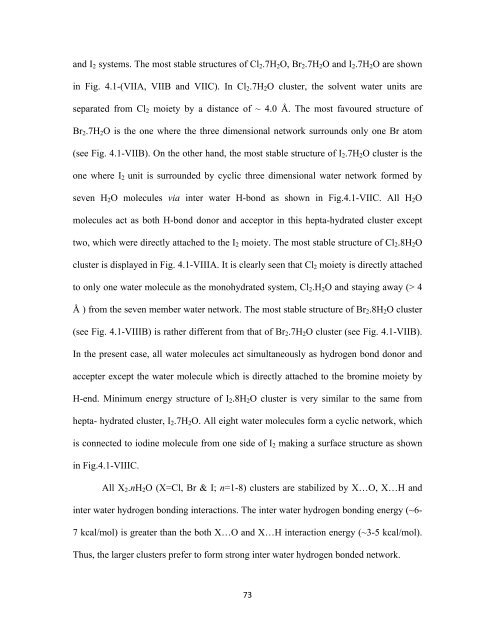CHEM01200604005 A. K. Pathak - Homi Bhabha National Institute
CHEM01200604005 A. K. Pathak - Homi Bhabha National Institute
CHEM01200604005 A. K. Pathak - Homi Bhabha National Institute
Create successful ePaper yourself
Turn your PDF publications into a flip-book with our unique Google optimized e-Paper software.
and I 2 systems. The most stable structures of Cl 2 .7H 2 O, Br 2 .7H 2 O and I 2 .7H 2 O are shown<br />
in Fig. 4.1-(VIIA, VIIB and VIIC). In Cl 2 .7H 2 O cluster, the solvent water units are<br />
separated from Cl 2 moiety by a distance of ~ 4.0 Å. The most favoured structure of<br />
Br 2 .7H 2 O is the one where the three dimensional network surrounds only one Br atom<br />
(see Fig. 4.1-VIIB). On the other hand, the most stable structure of I 2 .7H 2 O cluster is the<br />
one where I 2 unit is surrounded by cyclic three dimensional water network formed by<br />
seven H 2 O molecules via inter water H-bond as shown in Fig.4.1-VIIC. All H 2 O<br />
molecules act as both H-bond donor and acceptor in this hepta-hydrated cluster except<br />
two, which were directly attached to the I 2 moiety. The most stable structure of Cl 2 .8H 2 O<br />
cluster is displayed in Fig. 4.1-VIIIA. It is clearly seen that Cl 2 moiety is directly attached<br />
to only one water molecule as the monohydrated system, Cl 2 .H 2 O and staying away (> 4<br />
Å ) from the seven member water network. The most stable structure of Br 2 .8H 2 O cluster<br />
(see Fig. 4.1-VIIIB) is rather different from that of Br 2 .7H 2 O cluster (see Fig. 4.1-VIIB).<br />
In the present case, all water molecules act simultaneously as hydrogen bond donor and<br />
accepter except the water molecule which is directly attached to the bromine moiety by<br />
H-end. Minimum energy structure of I 2 .8H 2 O cluster is very similar to the same from<br />
hepta- hydrated cluster, I 2 .7H 2 O. All eight water molecules form a cyclic network, which<br />
is connected to iodine molecule from one side of I 2 making a surface structure as shown<br />
in Fig.4.1-VIIIC.<br />
All X 2 .nH 2 O (X=Cl, Br & I; n=1-8) clusters are stabilized by X…O, X…H and<br />
inter water hydrogen bonding interactions. The inter water hydrogen bonding energy (~6-<br />
7 kcal/mol) is greater than the both X…O and X…H interaction energy (~3-5 kcal/mol).<br />
Thus, the larger clusters prefer to form strong inter water hydrogen bonded network.<br />
73
















